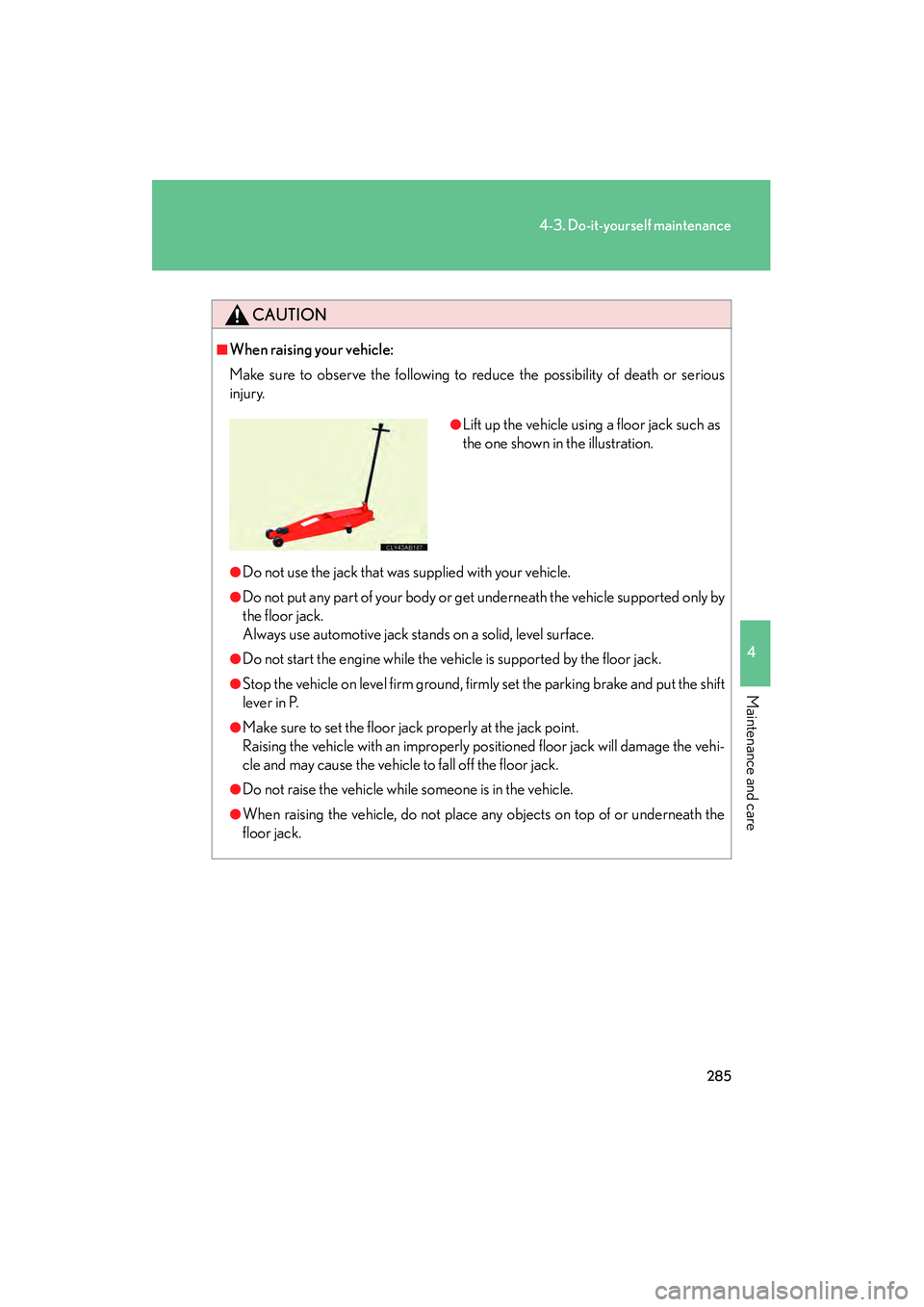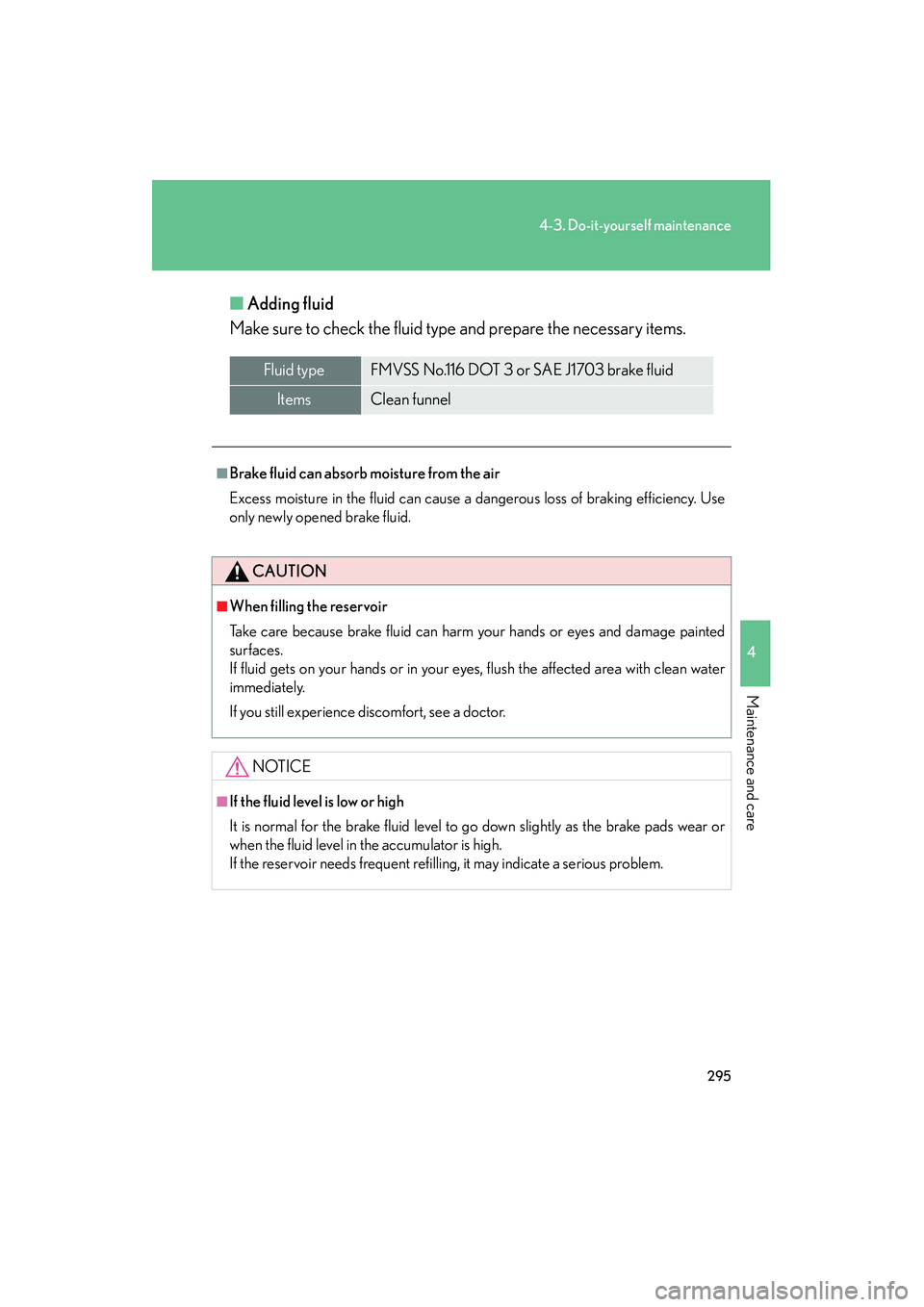brake Lexus IS F 2009 Owner's Guide
[x] Cancel search | Manufacturer: LEXUS, Model Year: 2009, Model line: IS F, Model: Lexus IS F 2009Pages: 458, PDF Size: 6.33 MB
Page 277 of 458

276
4-2. Maintenance
08_IS F_U_(L/O_0808)
General maintenance
Engine compartment
ItemsCheck points
BatteryMaintenance-free. (→P. 2 9 6 )
Brake fluidAt the correct level? ( →P. 2 9 4 )
Engine coolantAt the correct level? ( →P. 2 9 2 )
Engine oilAt the correct level? ( →P. 288)
Exhaust systemNo fumes or strange sounds?
Radiator/condenser/hosesNot blocked with foreign matter?
(→ P. 2 9 4 )
Wa s h e r f l u i dAt the correct level? ( →P. 299)
Listed below are the general maintenance items that should be performed
at the intervals specified in the “Warranty and Services Guide” or “Owners
Manual Supplement”. It is recommended that any problem you notice
should be brought to the attention of your Lexus dealer or qualified service
shop for advice.
Page 278 of 458

277
4-2. Maintenance
4
Maintenance and care
08_IS F_U_(L/O_0808)
Vehicle interior
ItemsCheck points
Accelerator pedal• Moves smoothly (without uneven pedal effort or catching)?
Automatic transmission “Park”
mechanism• Can the vehicle be held securely on an incline with the shift lever in
P?
Brake pedal
• Moves smoothly?
• Does it have appropriate clearance and correct amount of free play?
Brakes
• Not pull to one side when applied?
• Loss of brake effectiveness?
• Spongy feeling brake pedal?
• Pedal almost touches floor?
Head restraints• Move smoothly and lock securely?
Indicators/buzzers•Function properly?
Lights
• Do all the lights come on?
• Headlights aimed correctly? (→ P. 3 3 6 )
Pa r k i n g b r a ke
• Moves smoothly?
• Can hold the vehicle securely on
an incline?
Seat belts
• Does the seat belt system operate smoothly?
• Are the belts undamaged?
Seats• Do the seat controls operate prop- erly?
Page 281 of 458

280
08_IS F_U_(L/O_0808)
4-3. Do-it-yourself maintenance
Do-it-yourself service precautions
If you perform maintenance yourself, be sure to follow the correct proce-
dure as given in these sections.
ItemsParts and tools
Battery condition ( →P. 296)
•Warm water
• Baking soda
•Grease
•Conventional wrench
(for terminal clamp bolts)
Brake fluid level (→ P. 2 9 4 )
• FMVSS No.116 DOT 3 or SAE
J1703 brake fluid
•Rag or paper towel
• Funnel (used only for adding brake
fluid)
Engine coolant level ( →P. 2 9 2 )
• “Toyota Super Long Life Coolant”
or similar high-quality ethylene gly-
col-based non-silicate, non-amine,
non-nitrite and non-borate coolant
with long-life hybrid organic acid
technology.
For the U.S.A.:
“Toyota Super Long Life Coolant”
is pre-mixed with 50% coolant and
50% deionized water.
For Canada:
“Toyota Super Long Life Coolant”
is pre-mixed with 55% coolant and
45% deionized water.
• Funnel (used only for adding
engine coolant)
Page 286 of 458

285
4-3. Do-it-yourself maintenance
4
Maintenance and care
08_IS F_U_(L/O_0808)
CAUTION
■When raising your vehicle:
Make sure to observe the following to reduce the possibility of death or serious
injury.
●Do not use the jack that was supplied with your vehicle.
●Do not put any part of your body or get underneath the vehicle supported only by
the floor jack.
Always use automotive jack stands on a solid, level surface.
●Do not start the engine while the vehicle is supported by the floor jack.
●Stop the vehicle on level firm ground, firmly set the parking brake and put the shift
lever in P.
●Make sure to set the floor jack properly at the jack point.
Raising the vehicle with an improperly positioned floor jack will damage the vehi-
cle and may cause the vehicle to fall off the floor jack.
●Do not raise the vehicle while someone is in the vehicle.
●When raising the vehicle, do not place any objects on top of or underneath the
floor jack.
●Lift up the vehicle using a floor jack such as
the one shown in the illustration.
Page 287 of 458

286
4-3. Do-it-yourself maintenance
08_IS F_U_(L/O_0808)
Engine compartment
Battery (→P. 2 9 6 )
Engine oil level dipstick (→P. 288)
Engine oil filler cap (→P. 288)
Brake fluid reservoir (→P. 2 9 4 )
Fuse boxes ( →P. 322)Washer fluid tank
(→P. 299)
Electric cooling fans
Condenser ( →P. 2 9 4 )
Radiator ( →P. 2 9 4 )
Engine coolant reservoir (→P. 2 9 2 )
Page 295 of 458

294
4-3. Do-it-yourself maintenance
08_IS F_U_(L/O_0808)
Radiator and condenserCheck the radiator and condenser, and clear any foreign objects.
If either of the above parts are extremely dirty or you are not sure of their
condition, have your vehicle checked by your Lexus dealer.
Brake fluid■ Checking fluid level
The brake fluid level should be
between the “MAX” and “MIN”
lines on the tank.
CAUTION
■When the engine is hot
Do not touch the radiator or condenser, as they may be hot and you may be burned.
Page 296 of 458

295
4-3. Do-it-yourself maintenance
4
Maintenance and care
08_IS F_U_(L/O_0808)■
Adding fluid
Make sure to check the fluid type and prepare the necessary items.
Fluid typeFMVSS No.116 DOT 3 or SAE J1703 brake fluid
ItemsClean funnel
■Brake fluid can absorb moisture from the air
Excess moisture in the fluid can cause a dangerous loss of braking efficiency. Use
only newly opened brake fluid.
CAUTION
■When filling the reservoir
Take care because brake fluid can harm your hands or eyes and damage painted
surfaces.
If fluid gets on your hands or in your eyes, flush the affected area with clean water
immediately.
If you still experience discomfort, see a doctor.
NOTICE
■If the fluid level is low or high
It is normal for the brake fluid level to go down slightly as the brake pads wear or
when the fluid level in the accumulator is high.
If the reservoir needs frequent refilling, it may indicate a serious problem.
Page 346 of 458

5
When trouble arises
345
5-1. Essential information
08_IS F_U_(L/O_0808)
If your vehicle needs to be towed
Before towingThe following may indicate a problem with your transmission. Contact
your Lexus dealer before towing.
● The engine is running, but the vehicle will not move.
● The vehicle makes an abnormal sound.
Emergency towing
If a tow truck is not available, in an emergency your vehicle may be tem-
porarily towed using a cable or chain secured to the emergency towing
eyelet. This should only be attempted on hard, surfaced roads for short
distances at low speeds.
A driver must be in the vehicle to steer and operate the brakes. The vehi-
cle’s wheels, drive train, axles, steering and brakes must be in good condi-
tion. Towing eyelet
If towing is necessary, we recommend having your vehicle towed by your
Lexus dealer or a commercial towing se rvice, using a lift-type truck or a flat
bed truck.
Use a safety chain system for all towing, and abide by all state/provincial
and local laws.
If towing from the rear, the vehicle’s front wheels and axles must be in good
condition. ( →P. 3 4 9 )
If they are damaged, use a towing dolly or flat bed truck.
Page 347 of 458

346
5-1. Essential information
08_IS F_U_(L/O_0808)
■Emergency towing procedureRelease the parking brake.
Shift the shift lever to N.
Put the “ENGINE START STOP” switch in ACCESSORY mode (engine
off) or IGNITION ON mode (engine running).
CAUTION
■Caution while towing
●Use extreme caution when towing the vehicle.
Avoid sudden starts or erratic driving maneuvers which place excessive stress on
the emergency towing eyelet and the cables or chains.
●If the engine is not running, the power assist for the brakes and steering will not
function, making steering and braking more difficult.
NOTICE
■To prevent causing serious damage to the transmission
Never tow this vehicle from the rear with four wheels on the ground. This may cause
serious damage to the transmission.
STEP1
STEP2
STEP3
Page 352 of 458

5
When trouble arises
351
5-1. Essential information
08_IS F_U_(L/O_0808)
If you think something is wrong
If you notice any of the following symptoms, your vehicle probably needs
adjustment or repair. Contact your Lexus dealer as soon as possible.
■Visible symptoms
●Fluid leaks under the vehicle
(Water dripping from the air conditioning after use is normal.)
● Flat-looking tires or uneven tire wear
● Engine coolant temperature gauge needle continually points
higher than normal
■ Audible symptoms
●Changes in exhaust sound
● Excessive tire squeal when cornering
● Strange noises related to the suspension system
● Pinging or other noises related to the engine
■ Operational symptoms
●Engine missing, stumbling or running rough
● Appreciable loss of power
● Vehicle pulls heavily to one side when braking
● Vehicle pulls heavily to one side when driving on a level road
● Loss of brake effectiveness, sp ongy feeling, pedal almost touches
the floor